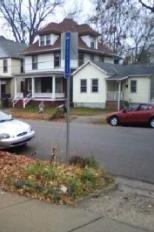






--The Bus Stops Here is produced monthly by members of the Madison Area Bus Advocates
Have you ever wondered why the bus stops half a block away from many bus stop signs?  Bus stop only signs face the street, and only a few tell pedestrians where the stop is (Photo from Long-Range Metro Transit Planning Ad Hoc Committee Final Report)Have you ever tried to find where the bus stop is when you are on the sidewalk but all the signs face the street so you cannot tell which is which? Ever wondered why? Ever wanted the bus to stop at a designated stop but it could not because a car was parked there? Ever wondered why? And when you asked the driver to call in and report the parked car, the reply was, “It’ll do no good. I used to call in but instead of doing something they have told me to stop calling them.” Or even worse, “I’d get in trouble.” Ever wonder why a bus rider might feel like a second-class citizen?
Bus stop only signs face the street, and only a few tell pedestrians where the stop is (Photo from Long-Range Metro Transit Planning Ad Hoc Committee Final Report)Have you ever tried to find where the bus stop is when you are on the sidewalk but all the signs face the street so you cannot tell which is which? Ever wondered why? Ever wanted the bus to stop at a designated stop but it could not because a car was parked there? Ever wondered why? And when you asked the driver to call in and report the parked car, the reply was, “It’ll do no good. I used to call in but instead of doing something they have told me to stop calling them.” Or even worse, “I’d get in trouble.” Ever wonder why a bus rider might feel like a second-class citizen?
To understand street signage is to enter into the realm of traffic engineering, not a particular strength of a transit geek (As similarly illogical as sidewalk snow clearance being under the purview of the Streets Department). It appears that in Madison, bus stop signs have for years actually been made and placed by people in the Traffic Engineering Department. Metro Transit pays for the signage and its placement out of its budget, but the work is actually done, and charged for, by Traffic Engineering. And as you know, Traffic Engineering is oriented toward cars, not pedestrians or bus riders.
Thus, as the six+ year-old picture indicates (p. 17 of the Long-Range Metro Transit Planning Ad Hoc Committee’s Final Report), the sign is located for the sake of cars, far away from where the bus actually stops to pick up or drop off passengers, and it is oriented toward the street where it can be seen by car drivers, not pedestrians on sidewalks. To the pedestrian on the sidewalk, the back of the sign can look as much like a parking sign or anything else of the same rectangular size and shape, as a bus stop. The only identifying feature of a bus stop sign is that its front is blue and, if applicable, it has a thin message fastened to the back saying that bus riders are to board the bus at the corner. If even the thin message is not there (the usual case), how are you to know that there is a bus stop there if you cannot see the front of the sign? Why, if Metro pays for the sign, is the sign not oriented toward pedestrians or located where the bus stops? Or are those questions too logical?
That is not all though, in case you are not frustrated enough. Because although the sign placement and orientation may have been overly car-oriented for years, but budget cuts (induced partly to “afford” costly road work) led Traffic Engineering some years ago to forego painting curbs to signal parking limitations. You may notice that the curb around a fire hydrant is no longer painted red, that temporary parking zones are no longer painted yellow or green, and that bus stops are no longer similarly awarded special coloring. In fact, all you will see to indicate that your car is not supposed to park in front of a bus stop – if you look closely enough that is – is a little crossed out capital P on the bus stop sign itself.
It is still against the law to park one’s car too close to a fire hydrant or bus stop, but motorists are often not sufficiently alerted and may not even be aware that certain areas should be left clear.
Since Madison does not have an overarching department of transportation the way most cities do, Metro supposedly advocates for bus riders at the periodic “team meetings” of the heads of the various public works and transportation departments.
Are we seeing the result of that advocacy? Improving the situation is not an issue of cost as Metro already pays for the signs. It is an issue of who controls the signs, who the signs are for, and why the control is where it is. And it is the reason we are an independent group of citizen bus advocates.
|
|
|
Welcome to the Madison Commons, a website designed to provide news and information about all of Madison's neighborhoods and a crossroads for the discussion of community issues. The name comes from the idea of a village commons, a place for news, talk, debate, and some entertainment, too, that's open to everyone.
All rights reserved. Read more about the Madison Commons and its partners.

